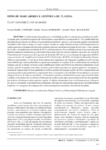Use este identificador para citar ou linkar para este item:
http://www.alice.cnptia.embrapa.br/alice/handle/doc/489101Registro completo de metadados
| Campo DC | Valor | Idioma |
|---|---|---|
| dc.contributor.author | CARNEIRO, N. P. | pt_BR |
| dc.contributor.author | GUIMARAES, C. T. | pt_BR |
| dc.contributor.author | MAGALHAES, J. V. | pt_BR |
| dc.date.accessioned | 2011-04-10T11:11:11Z | pt_BR |
| dc.date.available | 2011-04-10T11:11:11Z | pt_BR |
| dc.date.created | 2006-01-20 | pt_BR |
| dc.date.issued | 2004 | pt_BR |
| dc.identifier.citation | Bioscience Journal, Uberlândia, v. 20, p. 119-132, 2004. | pt_BR |
| dc.identifier.uri | http://www.alice.cnptia.embrapa.br/alice/handle/doc/489101 | pt_BR |
| dc.description | Plant breeding relies on genetic variation and selection to gradually improve plants for traits that are of interest to the grower and the consumer. This variability has been in part assessed through an efficient use of the available germplasm. Although breeding efforts have continuously produced improved varieties throughout the years, recent developments in the field of biotechnology and molecular biology can now be employed to facilitate and speed up cultivar development. These methods are mainly DNA-based techniques and basically use the hybridization of cloned probes to detect genomic sequences that are polymorphic for internal restriction sites, such as in restriction fragment length polymorphisms, or on the amplification of DNA fragments using the polymerase chain reaction (e.g. random amplified polymorphic DNA or simple sequence repeats (or microsatellites)). The amplified fragment length polymorphism method is conceptually a hybrid technique, relying on polymorphisms in the recognition sequences of restriction enzymes that are revealed through selective PCR amplification of adapter sequences. These techniques, when integrated with other resources such as mutants generated by chemical and insertional mutagenesis, quantitative trait locus mapping, cDNA sequencing projects, high throughput mass spectrometry and proteomics, physical and comparative mapping, have made gene cloning far more efficient. Advanced bioinformatic tools for data retrieval and subsequent statistical analysis have been developed, allowing for a quick and reliable management of enormous amount of data obtained in several plant species. The objective of the present manuscript is to offer an overview of the most common molecular markers used in the genetic analysis of traits that are relevant as targets for crop improvement. The advantages and disadvantages of current marker technologies are also discussed. | pt_BR |
| dc.language.iso | por | pt_BR |
| dc.rights | openAccess | pt_BR |
| dc.subject | Melhoramento de plantas | pt_BR |
| dc.title | Tipos de marcadores e genômica de plantas. | pt_BR |
| dc.type | Artigo de periódico | pt_BR |
| dc.date.updated | 2015-11-17T11:11:11Z | pt_BR |
| dc.subject.thesagro | Biologia Molecular | pt_BR |
| dc.subject.thesagro | Genética Molecular | pt_BR |
| dc.description.notes | Suplementt, 1. | pt_BR |
| riaa.ainfo.id | 489101 | pt_BR |
| riaa.ainfo.lastupdate | 2015-11-17 | pt_BR |
| dc.contributor.institution | NEWTON PORTILHO CARNEIRO, CNPMS; CLAUDIA TEIXEIRA GUIMARAES, CNPMS; JURANDIR VIEIRA DE MAGALHAES, CNPMS. | pt_BR |
| Aparece nas coleções: | Artigo em periódico indexado (CNPMS)  | |
Arquivos associados a este item:
| Arquivo | Descrição | Tamanho | Formato | |
|---|---|---|---|---|
| Tiposmarcadores.pdf | 399,7 kB | Adobe PDF |  Visualizar/Abrir |









